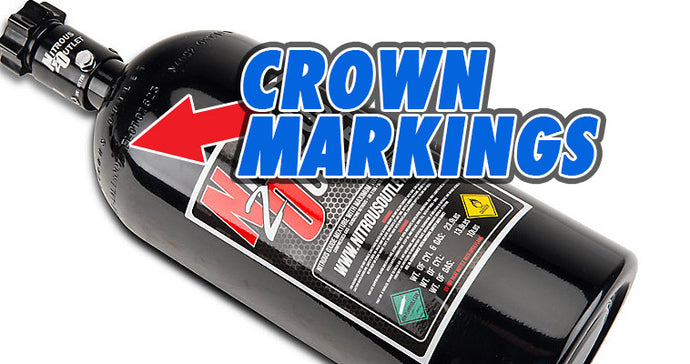Nitrous Bottle Crown Markings DEMYSTIFIED

Have you ever wondered what the stamped numbers and letters on the top of your nitrous bottle mean? Every bottle is required to have certain information on the bottle. This information is stamped on the crown of the bottle hence the name "Crowning Marks". It is imperative that you check the markings on your regularly, even if it's new. Unfortunately we have come across several manufactures sending out bottles that are out of certification with new systems.
- The Cylinder Manufacturer
- The Manufacture Date
- The DOT Approval Stamp
- The Transport Canada (TC) Approval Stamp
- The Service Pressure
- The Thread Type
- The Bottle Serial Number
- The Last Hydrostatic test Date
Let's look at an example. Say your Crown Markings look like this:
DOT-3AL1800 EL0111865 M4002 05C13 NO10 U18 TC-3ALM124 CATALINA
*DOT-3AL
The U.S. regulatory authority, the Department of Transportation (DOT), and specification, 3AL, to which the cylinder is manufactured in compliance. The 3ALM is the metal alloy that the bottle is made of.
*1800
The Service Pressure, pounds per square inch (psi), of the cylinder. The service pressure is used when determining tank calculations, such as the pressure for hydro testing. Do not confuse this number with the recommended operating pressure of the nitrous system, which is usually 900-1050psi.
EL0111865
The Serial number of the bottle. Company prefix followed by 7 digit number.
M4002
The M-Number or Manufactures Number issued by the DOT to the Manufacturer. For this bottle, Catalina Cylinders.
*05C15
The original hydrostatic test date of the cylinder, month followed by year, performed at the time of manufacture of the cylinder. The C represents the symbol of the Independent Inspection Agency (IIA) performing the inspection of and certifying the acceptance of the cylinder at the time of manufacture.
NO10
The cylinder identifier (product name). It identifies the market, “NO” for Nitrous Oxide, and capacity “10” for a capacity of 10lbs of N2O, of the cylinder.
U18
The cylinder outlet thread designation as specified in CGA TB-16. Nitrous Outlet bottles have a U18 thread designation, as do most other nitrous manufactures.
*TC-3ALM
The Canadian regulatory authority, Transport Canada (TC), and specification, 3ALM, to which the cylinder is manufactured in compliance.
*124
The service pressure of the cylinder expressed in metric units, bars.
CATALINA
The name of the manufacturer of the cylinder.
You might also see a brand name stamped onto the bottle. Some bottles are required to have the original owner stamped on the bottle, as well. Most nitrous bottles do not fall under this law, however; they are often stamped with a brand name.
Hydrotesting Dates:
For most people the Hydrostatic Test Date is the most important info on the bottle because it will tell you when your bottle needs to be recertified. Different types of cylinders have different testing requirements , but most nitrous bottles whose DOT numbers begin with 3ALM are required to be tested every 5 years, with an unlimited lifespan. Carbon Fiber bottles though, are different and depending on the manufacturer and date of manufacture the hydro testing requirements change. A Carbon Fiber cylinder may be good for 3 or 5 years, depending on the previous factors. If you have any doubt, contact the manufacturer of the cylinder. The Mustang below fell victim to a nitrous bottle explosion. The bottle was out of certification, left in the trunk on a hot day, and did not have a functioning safety relief disk.


Whats a Hydrostatic Test?
A hydrostatic test, sometimes called a hydro test or water jacket test, is a means of using water to test the structural integrity of the bottle. A hydrostatic test is done by submerging the cylinder under water in a sealed container. Then, the cylinder is filled with water and pressurized. However much water it displaces when under pressure will determine if the bottle will pass or fail the test. When the inspector passes your cylinder he will give it a new stamp that will look almost the same as your manufacture date stamp. If the bottle fails the hydro test, it will have a hole drilled into the cylinder in order to render it unusable. A failed hydro test just means that the bottle expanded more than allowable. With nitrous bottles, the most common cause of a cylinder failure is using a torch to heat the bottle. The rapid heating will cause rapid expansion and contraction of the metals composing the cylinder, and over time the metals will fatigue and become weak. Weakened cylinder walls containing 900+PSI of pressure can be catastrophic, not only to your property, but to you and others around you. Be safe, DO NOT TORCH YOUR BOTTLE and don’t skip your hydro test date.






Leave a comment